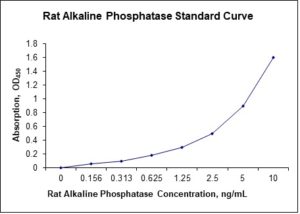Nori Rat ALP ELISA Kit
$461.00 – $832.00
This ELISA kit is for quantification of ALP in rat. This is a quick ELISA assay that reduces time to 50% compared to the conventional method, and the entire assay only takes 3 hours. This assay employs the quantitative sandwich enzyme immunoassay technique and uses biotin-streptavidin chemistry to improve the performance of the assays. An antibody specific for ALP has been pre-coated onto a microplate. Standards and samples are pipetted into the wells and any ALP present is bound by the immobilized antibody. After washing away any unbound substances, a detection antibody specific for ALP is added to the wells. Following wash to remove any unbound antibody reagent, a detection reagent is added. After intensive wash a substrate solution is added to the wells and color develops in proportion to the amount of ALP bound in the initial step. The color development is stopped, and the intensity of the color is measured.
Alternative names for ALP: Alkaline phosphatase (ALP, ALKP, ALPase, Alk Phos)
This product is for laboratory research use only not for diagnostic and therapeutic purposes or any other purposes.
- Description
- How Elisa Works
- Product Citations
- Reviews (0)
Description
Nori Rat ALP ELISA Kit Summary
Alternative names for ALP: Alkaline phosphatase (ALP, ALKP, ALPase, Alk Phos)
| Assay Type | Solid Phase Sandwich ELISA |
| Format | 96-well Microplate or 96-Well Strip Microplate |
| Method of Detection | Colorimetric |
| Number of Targets Detected | 1 |
| Target Antigen Accession Number |
P08239 |
| Assay Length | 3 hours |
| Quantitative/Semiquantitative | Quantitative |
| Sample Type | Plasma, Serum, Cell Culture, Urine, Cell/Tissue Lysates, Synovial Fluid, BAL, |
| Recommended Sample Dilution (Plasma/Serum) | No dilution for sample <ULOQ; sufficient dilution for samples >ULOQ |
| Sensitivity | 30 pg/mL |
| Detection Range | 0.156-10 ng/mL |
| Specificity | Rat ALP |
| Cross-Reactivity | < 0.5% cross-reactivity observed with available related molecules, < 50% cross-species reactivity observed with species tested. |
| Interference | No significant interference observed with available related molecules |
| Storage/Stability | 4 ºC for up to 6 months |
| Usage | For Laboratory Research Use Only. Not for diagnostic or therapeutic use. |
| Additional Notes | The kit allows for use in multiple experiments. |
Standard Curve
Kit Components
1. Pre-coated 96-well Microplate
2. Biotinylated Detection Antibody
3. Streptavidin-HRP Conjugate
4. Lyophilized Standards
5. TMB One-Step Substrate
6. Stop Solution
7. 20 x PBS
8. Assay Buffer
Other Materials Required but not Provided:
1. Microplate Reader capable of measuring absorption at 450 nm
2. Log-log graph paper or computer and software for ELISA data analysis
3. Precision pipettes (1-1000 µl)
4. Multi-channel pipettes (300 µl)
5. Distilled or deionized water
Protocol Outline
1. Prepare all reagents, samples and standards as instructed in the datasheet.
2. Add 100 µl of Standard or samples to each well and incubate 1 h at RT.
3. Add 100 µl of Working Detection Antibody to each well and incubate 1 h at RT.
4. Add 100 µl of Working Streptavidin-HRP to each well and incubate 20 min at RT.
5. Add 100 µl of Substrate to each well and incubate 5-30 min at RT.
6. Add 50 µl of Stop Solution to each well and read at 450 nm immediately.
Background:
Alkaline phosphatase (ALP, ALKP, ALPase, Alk Phos) is a hydrolase enzyme responsible for removing phosphate groups from many types of molecules, including nucleotides, proteins, and alkaloids.[1] In Mouses, alkaline phosphatase is present in all tissues throughout the entire body, but is particularly concentrated in liver, bile duct, kidney, bone, intestinal mucosa and the placenta. Normal ALP levels in adults are approximately 20 to 140 IU/L, though levels are significantly higher in children and pregnant women. Blood tests should always be interpreted using the reference range from the laboratory that performed the test. High ALP levels can occur if the bile ducts are obstructed. Also, ALP increases if there is active bone formation occurring, as ALP is a byproduct of osteoblast activity (such as the case in Paget’s disease of bone). Levels are also elevated in people with untreated Coeliac disease.[2] Lowered levels of ALP are less common than elevated levels. The source of elevated ALP levels can be deduced by obtaining serum levels of gamma glutamyl transferase (GGT). Concomitant increases of ALP with GGT should raise the suspicion of hepatobiliary disease.[3] Leukocyte alkaline phosphatase (LAP) is found within white blood cells. White blood cell levels of LAP can help in the diagnosis of certain conditions. Higher levels are seen in polycythemia vera (PV), essential thrombocytosis (ET), primary myelofibrosis (PM), and the leukemoid reaction. Lower levels are found in chronic myelogenous leukemia (CML), paroxysmal nocturnal hemoglobinuria (PNH) and acute myelogenous leukaemia (AML).
References
- Watanabe,S., et al. J. Biol. Chem. 264 (21), 12611-12619 (1989)
- Preussner, Harold T, HT (1998). American Family Physician 57 (5): 1023–1034.
- Schiele F, et al. (1998). Chem. Lab. Med. 36 (11): 871–8.
Be the first to review “Nori Rat ALP ELISA Kit”
You must be logged in to post a review.




























Reviews
There are no reviews yet.